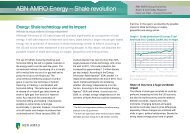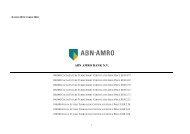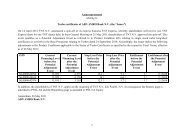ABN AMRO TURBOS - ABN AMRO Markets
ABN AMRO TURBOS - ABN AMRO Markets
ABN AMRO TURBOS - ABN AMRO Markets
Create successful ePaper yourself
Turn your PDF publications into a flip-book with our unique Google optimized e-Paper software.
The effect of dividends.<br />
Some underlyings issue dividends. Dividend payments will, under equal market circumstances,<br />
lead to a proportional decrease in the price of the underlying. In order to keep the value of the<br />
Turbo dividend-neutral, the financing level of the affected Turbos will be adjusted by the net<br />
dividend before the opening of the exchange on the ex-dividend date. For Turbos on Indices,<br />
the subtraction is done by the net amount, corrected for the weighting of the dividend-paying<br />
company in the Index.<br />
NOTE: Market conditions prevailing at the time of the dividend payment may cause the price<br />
of the underlying instrument to remain flat or rise. This will have a positive effect on the value<br />
of a Turbo Long and a negative effect on the value of a Turbo Short.<br />
For example, suppose you hold a Turbo Long with a financing level of EUR 10. The underlying<br />
of the Turbo is listed at EUR 15 and pays out a net dividend of EUR 1. To keep the value of the<br />
Turbo dividend-neutral, the financing level of the Turbo will be adjusted downwards by EUR 1<br />
before the opening of the exchange on the ex-dividend date:<br />
Underlying Financing level Value Turbo<br />
Pre-dividend 15 10 5<br />
Ex-dividend 14 9 5<br />
The effect of futures.<br />
Some Turbos are issued with a futures contract as underlying. Examples include Turbos on<br />
certain commodities and Turbos on bonds. Futures contracts are standardised contracts<br />
between two parties to buy or sell a specified quantity of a specified asset at a specified<br />
future date at a price agreed today. The price of these Turbos is therefore based on a future<br />
price, whereas Turbos that do not have a futures contract as underlying are based on the spot<br />
price, the price for direct settlement of the underlying.<br />
Normally there is a close correlation between the price movement of the underlying of<br />
the futures contract on the spot market and prices quoted on the futures contract on the<br />
corresponding futures markets. However, futures contracts are generally traded at a discount<br />
or premium to the spot price of the underlying of the futures contract. Contango is a situation<br />
in which the future price exceeds the spot price, often due to the cost of storing and insuring<br />
the underlying. The opposite of contango is backwardation. Backwardation is a market<br />
condition in which a futures price is lower in the distant delivery months than in the near<br />
delivery months. This can occur when the convenience yield is higher than the prevailing<br />
risk-free rate. Furthermore, depending on the relevant underlying, there can be significant<br />
differences in the liquidity of the futures and the spot markets. As expiration of the futures<br />
contract approaches, the future price normally moves towards the spot price.<br />
Futures have an expiration date (strike date) on which settlement of the underlying contract<br />
is required through either physical delivery or cash settlement. To prevent settlement of<br />
the underlying and to ensure continuation of the Turbo, futures contracts are rolled prior to<br />
expiration by selling the expiring contract and acquiring the succeeding (most liquid) contract.<br />
6






